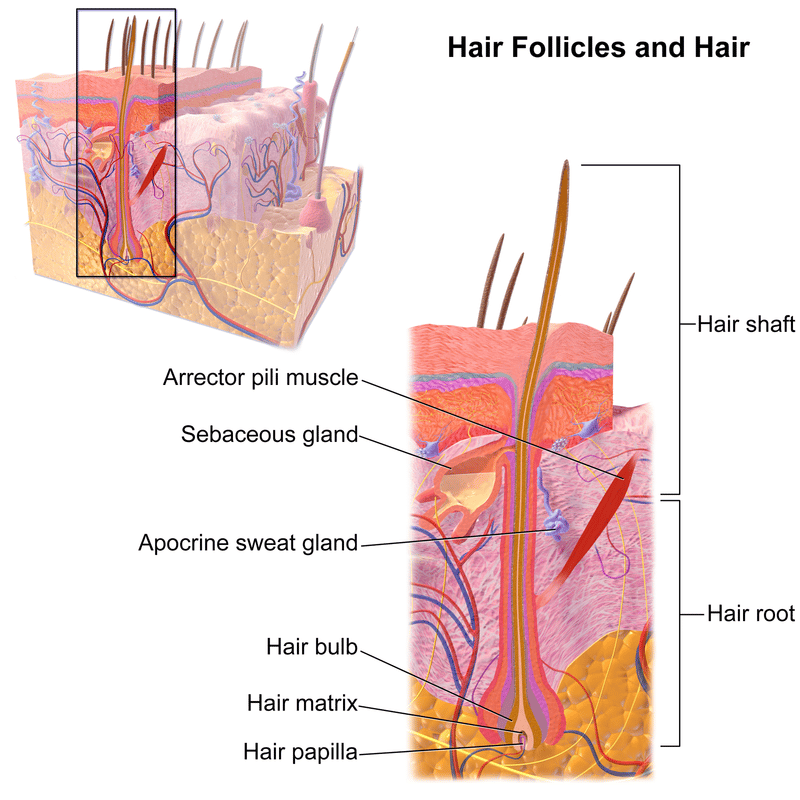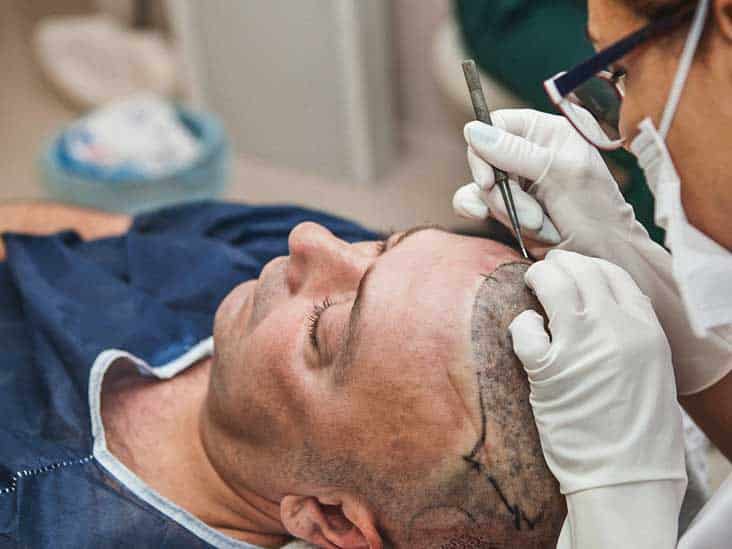Hair Transplant Surgery – Overview
Hair transplant surgery is a surgical procedure that involves the removal of hair follicles from one part of the body, known as the ‘donor site’, to a bald part of the body known as the ‘recipient site’.
The donor sites for a hair transplant are parts of the body that are naturally resistant to balding such as the back or side of the head and the hair follicles can be transplanted to restore balding head, beard hair, eyebrows, chest hair, etc.
The procedure is usually carried out as a form of treatment for hair loss (alopecia) from male or female pattern baldness, burns, cancer, or accidents.

hair follicle
Types of Hair Transplant Surgery
There are different types of hair transplant surgery depending on the application of the procedure. Some of the types of hair transplant surgery include:
- Androgenetic alopecia
- Eyebrow transplant
- Frontal hairline reconstruction
Androgenetic alopecia
This is also known as male-pattern baldness and it refers to the permanent hair loss from the scalp causing baldness.
There is a growing body of literature aimed at elucidating the effect of hair loss on quality of life. Studies demonstrate that individuals experiencing hair loss have reduced self-esteem and self-confidence as well as higher self-consciousness, all of which may place them at a social disadvantage. As a result, hair transplant surgery is among the most common plastic surgery sought by men.
Eyebrow transplant
As the name implies, eyebrow transplant is a type of hair transplant whereby the hair is transplanted to the eyebrows. There may be a loss of eyebrows due to aging, scarring or illness and an eyebrow transplant is carried out to replace the loss of eyebrows.
Frontal hair line lowering/reconstruction
Hairline lowering surgery, also referred to as forehead reduction, is a highly effective way to move the hairline to a natural level. This surgical technique can effectively lower the hairline by up to 2 inches.

hair transplant surgery
Surgical Procedure for Hair transplant
Various methods of transplant surgery are available. Your surgeon will choose the surgery most appropriate for you, based on your circumstances.
The surgical procedure for hair transplant can generally be classified into three stages:
- Pre-operative assessment and planning
- Harvesting
- Transplantation
Pre-operative assessment and planning
You should visit your surgeon initially to discuss your preferences, expectations and the best approach for you. You may be recommended some vitamins and topical application of minoxidil. Alcohol and smoking can contribute to poor graft survival and the doctor will advise you to refrain from that several days before your hair transplant surgery.
Harvesting
After thoroughly cleaning your scalp, the surgeon uses a small needle to numb an area of your head with local anesthesia.
Since hair naturally grows in groupings of 1 to 4 hairs, current techniques harvest and transplant hair “follicular units” in their natural groupings. Thus modern hair transplantation can achieve a natural appearance by mimicking the original hair orientation. Donor hair can be harvested in two different ways: strip harvesting, and follicular unit extraction (FUE).
Strip harvesting – Strip harvesting is the most common technique for removing hair and follicles from a donor site. The surgeon harvests a strip of skin from the posterior scalp, in an area of good hair growth. The surgeon carefully removes strips of hair-bearing tissue containing intact hair follicles from the donor site.
The surgeons and their assistants work with stereo-microscopes to dissect the individual follicular unit grafts to make them functional and viable upon transplantation. Strip harvesting will leave a thin linear scar in the donor area, which is typically covered by a patient’s hair even at relatively short lengths. The recovery period is around 2 weeks and will require the stitches/staples to be removed by medical personnel or sub-cuticular suturing can be done.
Follicular unit extraction (FUE) – With FUE, the surgeon removes individual follicular units containing 1 to 4 hairs under local anesthesia. Afterward, the surgeon uses very small micro blades or fine needles to puncture the recipient sites to receive the grafts.
The procedure can take anywhere from a couple of hours to extract 200 grafts for a scar correction to a surgery over two consecutive days for a megasession of 2,500 to 3,000 grafts. As no suture removal is required, recovery from Micro Grafting FUE is less than 7 days. However, there is increased surgical times and higher cost to the patient.
Transplantation
The mainstream method for the transplantation stage is follicular unit transplantation (FUT). This technique involves the transplantation of the patient’s hair in naturally occurring groups of 1 to 4 hairs giving a more natural hair appearance. This technique is better and more refined than older techniques which gave a pluggy, unnatural look.
Related: Is Laser Hair Removal Safe?
Hair Transplant Side Effects
All surgery carries some degree of risk. Some of the possible complications and side effects of hair transplant surgery include:
– Risks of general anesthesia, including allergic reaction, which may (rarely) be fatal
– Bleeding
– Infection
– Scarring: The scars from hair transplantation may become severe, raised, reddened and itchy. This will generally resolve and be covered by the hair after some time.
– Nerve damage: There is a risk of nerve damage which may result in permanent loss of sensation
– Hair thinning: Also known as “shock loss”, is a common side effect that is usually temporary.
– Bald patches: These are also common, as fifty to a hundred hairs can be lost each day
– Hiccups: Hiccups are a common side-effect of hair transplant surgeries. 5 in 100 patients are affected by hiccups soon after the procedure. Although the cause for it is unknown, the hiccups can last from several hours to several days. This side-effect is seen in hair transplant patients more often than it is seen in scalp reduction patients.
Hair Transplant Cost
Cosmetic surgery does not usually qualify for rebates from Medicare or private health insurance companies. If the hair loss was caused by burns or trauma, however, hair replacement surgery is considered a reconstructive treatment and may be covered by health insurance.
The total cost for hair transplant surgery depends on a lot of factors such as the anesthetic fee, private hospital fee, private operating facility fee, and the type of transplant.
The total cost of the procedure is around $4,000 – $15,000.
Hair Transplant Success rate
The success rate of a hair transplant depends on several factors such as the surgical technique used, the experience of the surgeon and the patient’s habits.
Some surgeons note that follicular unit extraction (FUE) can lead to a lower ratio of successfully transplanted follicles as compared to strip harvesting.
The more experienced the surgeon the higher the success rate for hair transplant surgery. Also, alcohol and smoking can contribute to poor graft survival. The success rate of hair transplants is very high, as high as 98 percent when the procedure is performed properly.
More: Rib Removal Surgery


